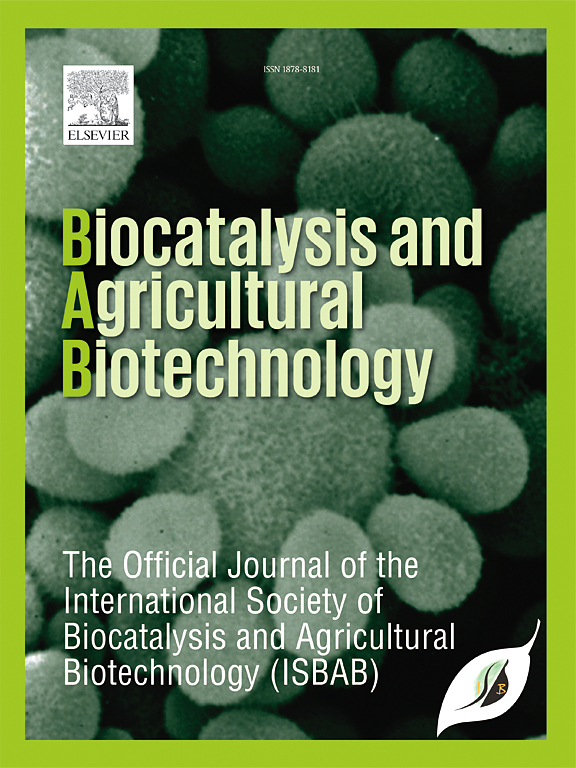Biogenic selenium nanoparticles as nanopriming agents: Promoting germination and strengthening antioxidant defense in rice (Oryza sativa L.)
IF 3.4
Q2 BIOTECHNOLOGY & APPLIED MICROBIOLOGY
引用次数: 0
Abstract
Biogenic synthesis of nanoparticles is an emerging and trending technology. Greener approaches are more sustainable, less invasive and economical. The contemporary study focuses on the synthesis of selenium nanoparticles (Se-NPs) using Hibiscus rosa-sinensis leaf extract and evaluating their nanopriming effect on rice seeds. The biophysical characteristics of Se-NPs were evaluated using techniques like ultraviolet–visible spectroscopy, fourier-transform infrared spectroscopy (FT-IR), X-ray diffraction, dynamic light scattering, scanning electron microscopy (SEM), atomic force microscopy (AFM) and electron probe microanalysis (EPMA). SEM and AFM analyses revealed spherical Se-NPs with an average diameter of 47.6 nm. FT-IR confirmed functional groups, aiding in the reduction and stabilization of the Se-NPs, while EPMA validated elemental selenium presence. Nanopriming with Se-NPs demonstrated a significant, dose-dependent increase in germination activity. This was evident in mean germination time (65 %), radicle and plumule length, fresh weight, and biochemical assays for total soluble sugar and protein content. Additionally, seed vigour and relative water uptake measurements strongly indicated that Se-NPs effectively boost germination and seedling growth. The reduction of free radicals was observed by 3,3′-diaminobenzidine and nitro blue tetrazolium staining, indicating strong antioxidant activity by application of Se-NPs. The increased activities of enzymes superoxide dismutase (SOD ≥28 %), catalase (CAT ≥46 %), peroxidase (POD ≥49 %), along with marked reduction in lipid peroxidation (MDA ≥23 %) evidently demonstrated that Se-NPs enhanced antioxidant defense. These findings suggest that selenium nanoparticles have bioactive potential in agriculture, particularly in improving plant growth. This warrants further exploration for efficient agricultural applications and creating a more sustainable environment.

生物源性纳米硒纳米化剂:促进水稻萌发和增强抗氧化防御
生物合成纳米颗粒是一种新兴的、有发展趋势的技术。更环保的方法更具可持续性,侵入性更小,也更经济。目前的研究重点是利用芙蓉叶提取物合成硒纳米粒子(Se-NPs),并评价其对水稻种子的纳米造粒效果。采用紫外-可见光谱、傅里叶变换红外光谱(FT-IR)、x射线衍射、动态光散射、扫描电子显微镜(SEM)、原子力显微镜(AFM)和电子探针显微分析(EPMA)等技术对Se-NPs的生物物理特性进行了评价。SEM和AFM分析显示Se-NPs为球形,平均直径为47.6 nm。FT-IR证实了官能团,有助于硒- nps的还原和稳定,而EPMA证实了元素硒的存在。硒- nps纳米膜显示出萌发活性显著的剂量依赖性增加。这在平均发芽时间(65%)、胚根和胚珠长度、鲜重以及总可溶性糖和蛋白质含量的生化测定中都很明显。此外,种子活力和相对水分吸收测量结果表明,硒-氮肥能有效促进种子萌发和幼苗生长。通过3,3′-二氨基联苯胺和硝基蓝四氮唑染色观察到自由基的减少,表明Se-NPs具有较强的抗氧化活性。超氧化物歧化酶(SOD≥28%)、过氧化氢酶(CAT≥46%)、过氧化物酶(POD≥49%)活性升高,脂质过氧化(MDA≥23%)活性明显降低,表明Se-NPs增强了抗氧化防御能力。这些发现表明纳米硒在农业中具有生物活性潜力,特别是在促进植物生长方面。这需要进一步探索有效的农业应用和创造更可持续的环境。
本文章由计算机程序翻译,如有差异,请以英文原文为准。
求助全文
约1分钟内获得全文
求助全文
来源期刊

Biocatalysis and agricultural biotechnology
Agricultural and Biological Sciences-Agronomy and Crop Science
CiteScore
7.70
自引率
2.50%
发文量
308
审稿时长
48 days
期刊介绍:
Biocatalysis and Agricultural Biotechnology is the official journal of the International Society of Biocatalysis and Agricultural Biotechnology (ISBAB). The journal publishes high quality articles especially in the science and technology of biocatalysis, bioprocesses, agricultural biotechnology, biomedical biotechnology, and, if appropriate, from other related areas of biotechnology. The journal will publish peer-reviewed basic and applied research papers, authoritative reviews, and feature articles. The scope of the journal encompasses the research, industrial, and commercial aspects of biotechnology, including the areas of: biocatalysis; bioprocesses; food and agriculture; genetic engineering; molecular biology; healthcare and pharmaceuticals; biofuels; genomics; nanotechnology; environment and biodiversity; and bioremediation.
 求助内容:
求助内容: 应助结果提醒方式:
应助结果提醒方式:


